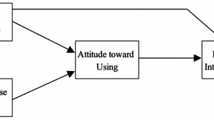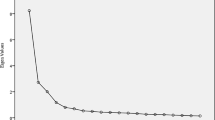Abstract
Digital technology is profoundly transforming various aspects of life, thus highlighting the need to enhance digital literacy on a national scale. In primary and secondary schools, artificial intelligence (AI) education plays a pivotal role in fostering digital literacy. To comprehensively investigate the variables influencing AI education in primary and secondary schools, a dynamic system model was constructed based on the CIPP (Context, Input, Process, and Product) education evaluation model. We employed a mixed-method research approach, combining both qualitative and quantitative methods, to thoroughly investigate the influencing factors and perform predictive and simulation experiments. Firstly, we construct a system framework for AI education in primary and secondary schools based on CIPP model, utilizing qualitative methods such as literature review and expert interviews to identify influencing factors and define the system’s boundaries. Secondly, we collect 814 questionnaire responses from 12 primary and secondary schools and employ Structural Equation Modeling (SEM) for quantitative analysis to explore the relationships between these influencing factors. Finally, these relationships are utilized to construct a System Dynamics model, allowing for an in-depth exploration of the development trends in AI education in primary and secondary schools through predictive analysis and control simulation. Controlled simulations allow us to predict and validate factors that influence the level of AI education development, aiding in the identification of high-leverage elements. Our findings underscore that AI education in Chinese primary and secondary schools is still in its initial stage with insufficient developmental momentum. Through controlled simulation results, it is found that the development of AI education in primary and secondary schools is influenced by both external systems and internal student systems, with national policy serving as the fundamental driving force. Among these influencing factors, societal factors play a predominant role in the external environment, followed by school factors, while the students’ level of learning engagement is identified as the most crucial factor within the internal system. Based on the results of prediction and simulation studies, recommendations for improvement are proposed, including policy reforms and collaboration between schools and enterprises.
Access this article
We’re sorry, something doesn't seem to be working properly.
Please try refreshing the page. If that doesn't work, please contact support so we can address the problem.








Similar content being viewed by others
Explore related subjects
Discover the latest articles, news and stories from top researchers in related subjects.Data availability
The datasets used and analyzed during the current study are available from the corresponding author on reasonable request.
References
Adams, C., Pente, P., Lemermeyer, G., & Rockwell, G. (2023). Ethical principles for artificial intelligence in K-12 education. Computers Education: Artificial Intelligence, 4, 100131. https://doi.org/10.1016/j.caeai.2023.100131.
AIK12. (2019). Five Big Ideas about AI. Retrieved from https://ai4k12.org/big-idea-1-overview/
Akgun, S., & Greenhow, C. (2021). Artificial intelligence in education: Addressing ethical challenges in K-12 settings. AI and Ethics, 2, 431–440. https://doi.org/10.1007/s43681-021-00096-7.
Ali, S., Payne, B. H., Williams, R., Park, H. W., & Breazeal, C. (2019). Constructionism, ethics, and creativity: Developing primary and middle school artificial intelligence education. In International workshop on education in artificial intelligence k-12 (eduai’19), 2, 1–4
Alivernini, F., & Manganelli, S. (2015). Country, school and students factors associated with extreme levels of science literacy across 25 countries. International Journal of Science Education, 37(12), 1992–2012. https://doi.org/10.1080/09500693.2015.1060648.
Biroscak, B. J., Bryant, C., Khaliq, M., Schneider, T., Panzera, A. D., Courtney, A., Parvanta, C., & Hovmand, P. (2019). Using system dynamics modeling to evaluate a community-based social marketing framework: A computer simulation study. Journal of Social Marketing, 9(1), 53–76. https://doi.org/10.1108/JSOCM-01-2018-0014.
Borenstein, J., & Howard, A. (2021). Emerging challenges in AI and the need for AI ethics education. AI and Ethics, 1, 61–65. https://doi.org/10.1007/s43681-020-00002-7.
Burkell, J., Schneider, B., & Pressley, M. (1990). Mathematics. In M. Pressley (Ed.), cognitive strategy instruction that really improves children’s academic performance (pp. 147–177). Brookline Books
Chai, C. S., Lin, P. Y., Jong, M. S. Y., Dai, Y., Chiu, T. K., & Huang, B. (2020). Factors influencing students’ behavioral intention to continue artificial intelligence learning. In 2020 international symposium on educational technology (ISET), Bangkok, Thailand, 147–150. IEEE. https://doi.org/10.1109/ISET49818.2020.00040
DigComp. (2022). DigComp 2.2: The Digital Competence Framework for Citizens - With new examples of knowledge, skills and attitudes. Retrieved from https://publicatins.jrc.ec.europa.eu/repository/handle/ JRC12 8415
Dragoş, V., & Mih, V. (2015). Scientific literacy in school. Procedia-Social and Behavioral Sciences, 209, 167–172. https://doi.org/10.1016/j.sbspro.2015.11.273.
Fornell, C., & Larcker, D. (1981). Structural equation models with unobservable variables and measurement error. Journal of Marketing Research, 18(1), 39–50
Forrester, J. W. (2016). Learning through system dynamics as preparation for the 21st century. System Dynamics Review, 32(3–4), 187–203. https://doi.org/10.1002/sdr.1571.
Hair, J. F. Jr., Black, W. C., Babin, B. J., & Anderson, R. E. (2010). Multivariate data analysis (7th ed.). Prentice Hall
Henry, J., Hernalesteen, A., & Collard, A. S. (2021). Teaching artificial intelligence to K-12 through a role-playing game questioning the intelligence concept. KI-Künstliche Intelligenz, 35(2), 171–179. https://doi.org/10.1007/s13218-021-00733-7.
Henseler, J., Ringle, C. M., & Sarstedt, M. (2015). A new criterion for assessing discriminant validity in variance-based structural equation modeling. Journal of the Academy of Marketing Science, 43, 115–135. https://doi.org/10.1007/s11747-014-0403-8.
Huang, X. (2021). Aims for cultivating students’ key competencies based on artificial intelligence education in China. Education and Information Technologies, 26, 5127–5147. https://doi.org/10.1007/s10639-021-10530-2.
International Society for Technology in Education (ISTE). (2022). Hands-on AI projects for the class-room Retrieved from https://cdn.iste.org/www-root/Libraries/Documents%20%26%20Files/Artificial%20Intelligence/AIGDK5_1120.pdf
Jobin, A., Ienca, M., & Vayena, E. (2019). The global landscape of AI ethics guidelines. Nature Machine Intelligence, 1(9), 389–399. https://doi.org/10.1038/s42256-019-0088-2.
Kim, S. W., & Lee, Y. (2023). Investigation into the influence of Socio-Cultural factors on attitudes toward Artificial Intelligence. Education and Information Technologies, 1–29. https://doi.org/10.1007/s10639-023-12172-y.
Kim, H. S., Kil, H. J., & Shin, A. (2014). An analysis of variables affecting the ICT literacy level of Korean elementary school students. Computers & Education, 77, 29–38. https://doi.org/10.1016/j.compedu.2014.04.009.
Kong, S. C., Cheung, W. M. Y., & Tsang, O. (2023). Evaluating an artificial intelligence literacy programme for empowering and developing concepts, literacy and ethical awareness in senior secondary students. Education and Information Technologies, 28, 4703–4724. https://doi.org/10.1007/s10639-022-11408-7.
Laupichler, M. C., Aster, A., Schirch, J., & Raupach, T. (2022). Artificial intelligence literacy in higher and adult education: A scoping literature review. Computers & Education: Artificial Intelligence, 100101. https://doi.org/10.1016/j.caeai.2022.100101.
Lin, P. Y., Chai, C. S., Jong, M. S. Y., Dai, Y., Guo, Y., & Qin, J. (2021). Modeling the structural relationship among primary students’ motivation to learn artificial intelligence. Computers & Education: Artificial Intelligence, 2, 100006. https://doi.org/10.1016/j.caeai.2020.100006.
Long, D., & Magerko, B. (2020). What is AI literacy? Competencies and design considerations. In Proceedings of the 2020 CHI conference on human factors in computing systems, Honolulu, HI, USA, 1–16
Lu, Y., Tang, X., Song, J., & Yu, S. (2021). Artificial intelligence education in K-12 schools in the intelligent era: Strategic positioning and core content domains. Distance Education in China, 5, 22–31. https://doi.org/10.13541/j.cnki.chinade.2021.05.003.
Luu, K., & Freeman, J. G. (2011). An analysis of the relationship between information and communication technology (ICT) and scientific literacy in Canada and Australia. Computers & Education, 56(4), 1072–1082. https://doi.org/10.1016/j.compedu.2010.11.008.
Ng, D. T. K., Lee, M., Tan, R. J. Y., Hu, X., Downie, J. S., & Chu, S. K. W. (2022). A review of AI teaching and learning from 2000 to 2020. Education and Information Technologies, 1–57. https://doi.org/10.1007/s10639-022-11491-w.
Qudrat-Ullah, H. (2010). Perceptions of the effectiveness of system dynamics-based interactive learning environments: An empirical study. Computers & Education, 55(3), 1277–1286
Reparaz, C., & Sotés-Elizalde, M. A. (2019). Parental involvement in schools in Spain and Germany: Evidence from PISA 2015. International Journal of Educational Research, 93, 33–52. https://doi.org/10.1016/j.ijer.2018.10.001.
Roberts, D. A., & Bybee, R. W. (2014). Scientific literacy, science literacy, and science education. Handbook of research on science education, volume II (pp. 559–572). Routledge
Rozek, C. S., Hyde, J. S., Svoboda, R. C., Hulleman, C. S., & Harackiewicz, J. M. (2015). Gender differences in the effects of a utility-value intervention to help parents motivate adolescents in mathematics and science. Journal of Educational Psychology, 107(1), 195. https://doi.org/10.1037/a0036981.
Sanusi, I. T., Olaleye, S. A., Oyelere, S. S., & Dixon, R. A. (2022a). Investigating learners’ competencies for artificial intelligence education in an African K-12 setting. Computers Education Open, 3, 100083. https://doi.org/10.1016/j.caeo.2022.100083.
Sanusi, I. T., Olaleye, S. A., Agbo, F. J., & Chiu, T. K. (2022b). The role of learners’ competencies in artificial intelligence education. Computers and Education: Artificial Intelligence, 3, 100098. https://doi.org/10.1016/j.caeai.2022.100098.
State Council. (2017). New generation of artificial intelligence development plan. The Foundation for Law and International Affairs. July 8, 1–28. Available at: https://flia.org/wp-content/uploads/2017/07/A-New-Generation-of-Artificial-Intelligence-Development-Plan-1.pdf
Stufflebeam, D. L. (2000). The CIPP model for evaluation. Evaluation models: Viewpoints on educational and human services evaluation (pp. 279–317). Springer Netherlands
Touretzky, D., Gardner-McCune, C., Martin, F., & Seehorn, D. (2019). Envisioning AI for K-12: What should every child know about AI? In Proceedings of the AAAI conference on artificial intelligence, Honolulu, Hawaii, USA, 33(1), 9795–9799. https://doi.org/10.1609/aaai.v33i01.33019795
UNESCO. (2021). K-12 AI curricula: A mapping of government-endorsed AI curricula. Retrieved from https://unesdoc.unesco.org/ark:/48223/pf0000380602
Wong, G. K., Ma, X., Dillenbourg, P., & Huan, J. (2020). Broadening artificial intelligence education in K-12: Where to start? ACM Inroads, 11(1), 20–29
Wu, F., Lu, C., Zhu, M., Chen, H., & Pan, Y. (2020). Towards a new generation of artificial intelligence in China. Nature Machine Intelligence, 2(6), 312–316
Yang, W. (2022). Artificial Intelligence education for young children: Why, what, and how in curriculum design and implementation. Computers Education: Artificial Intelligence, 3, 100061. https://doi.org/10.1016/j.caeai.2022.100061.
Yang, X., Ram, N., Lougheed, J. P., Molenaar, P., & Hollenstein, T. (2019). Adolescents’ emotion system dynamics: Network-based analysis of physiological and emotional experience. Developmental Psychology, 55(9), 1982. https://doi.org/10.1037/dev0000690.
Yau, K. W., Chai, C., Chiu, T. K., Meng, H., King, I., & Yam, Y. (2023). A phenomenographic approach on teacher conceptions of teaching artificial intelligence (AI) in K-12 schools. Education and Information Technologies, 28(1), 1041–1064. https://doi.org/10.1007/s10639-022-11161-x.
Acknowledgements
Not applicable.
Funding
This research was supported by the National Key R&D Program of China (Grant No. 2023YFC3305601), the State Key Program of National Natural Science of China (Grant No. U20A20229) and the Central China Normal University National Teacher Development Collaborative Innovation Experimental Base Construction Research Project (Grant No. CCNUTEIII 2021-03).
Author information
Authors and Affiliations
Contributions
Tao Huang is a contributor in terms of idea and creativity; Jing Geng is a contributor in terms of data collection and writing; Yuxia Chen and Han Wang are contributors in terms of Editing; Huali Yang and Shengze Hu are responsible for the editing work.
Corresponding author
Ethics declarations
Competing interests
The authors declare that they have no competing interests.
Additional information
Publisher’s Note
Springer Nature remains neutral with regard to jurisdictional claims in published maps and institutional affiliations.
Rights and permissions
Springer Nature or its licensor (e.g. a society or other partner) holds exclusive rights to this article under a publishing agreement with the author(s) or other rightsholder(s); author self-archiving of the accepted manuscript version of this article is solely governed by the terms of such publishing agreement and applicable law.
About this article
Cite this article
Huang, T., Geng, J., Chen, Y. et al. Simulation and prediction study of artificial intelligence education dynamics model for primary and secondary schools. Educ Inf Technol 29, 16749–16775 (2024). https://doi.org/10.1007/s10639-024-12470-z
Received:
Accepted:
Published:
Issue Date:
DOI: https://doi.org/10.1007/s10639-024-12470-z




